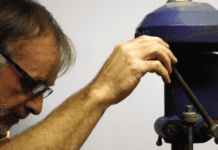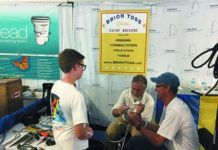No matter where you live in the U.S., summer is a time of heightened activity on the water. It’s also that time of year when we read or hear about mishaps and tragedies that easily might be avoided or their severity lessened if the people involved were a little better prepared or just a little more knowledgeable about spending time on the water.
Just recently in my home waters, two teenage boys went missing after they took to sea aboard a JY15 to go fishing for sharks. These fellows weren’t seasoned boaters and they didn’t mean to stray far from the beach, but 20-knot-plus winds and an ebb tide took them quickly out to sea, and out of their league.
Though they didn’t have much in the way of equipment to get themselves back ashore-no engine, no rudder, no rig or sails, and just two paddles-nor any means by which to contact or signal other vessels, they had a prodigious amount of faith.
Almost miraculously, these two contemporary Huck Finns survived starvation, dehydration, and exposure for nearly six days at sea, just drifting along the South Carolina coastline until a passing fisherman spotted their craft, roughly 111 miles north of where they had embarked.
Aided by state and local agencies, the U.S. Coast Guard began an extensive search and rescue operation some 20 hours after the boys’ departure. The combined search area covered 3,771 square miles, and involved 40 searches, but the circumstances were what one local journalist accurately termed “looking for a needle in a field of haystacks,” and the USCG suspended its search after less than 48 hours.
There are lessons to be gleaned from situations like these, and we can all stand to learn or relearn them from time to time. Among those: always let someone know where you’re headed before you leave shore; and always carry some means of communication. Of course none of us is without fault. I, too, have made blunders at sea, like fetching up on the southwest corner of Block Island in a pea-soup fog aboard an engineless 25-foot sloop when my dead reckoning said I should be approaching New Harbor, some 5 miles north. It never hurts to remind ourselves that we’re just one bad decision away from peril at sea.
With that in mind, consider that having some means to communicate with would-be rescuers might be the best resource for sailors in trouble. Whether it’s a whistle, a horn, or a VHF radio, you can’t make use of it if you don’t have it on board.
These days, a lot of coastal and inshore sailors are opting for the use of cellular phones as their primary means of communicating with shore-based contacts. Sources at Boat/US tell us that 35% of all cell phone calls received by their emergency service-Towboat/US-come from vessels without working VHF radios. This statistic implies an alarming rate of reliance upon cellular technology. As most users of cell phones can tell you, they ain’t all that reliable.
Boat/US officials caution that VHF radios are vital, particularly in emergencies. Unlike cell phones, VHF broadcasts are likely to be heard by other boaters nearby, and that could be critical if you’re taking on water or have a medical emergency. And, consider that skippers whose boats are in distress occasionally report inaccurate positions. The Coast Guard and an increasing number of private towing companies use direction finders that home in on VHF broadcasts to locate the boat. That’s a valuable tracking technique that isn’t possible with a cellular broadcast.
Fittingly, we’ll examine fixed-mount VHF radios in our July 15 edition. Until then, here’s hoping you benefit from the current issue.
-Dan Dickison



































